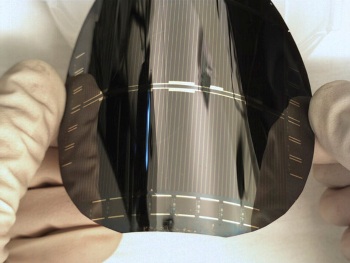Mar 13 2013
New awards totaling $6.6 million from Stanford University’s Global Climate and Energy Project (GCEP) will advance research on clean-burning fuels and technologies for capturing carbon dioxide (CO2) emissions. The funding will be shared by seven research teams – six from Stanford and one from Carnegie Mellon University.
 Stanford's Global Climate and Energy Project is supporting new research on thin-film solar cells and other clean-energy technologies.
Stanford's Global Climate and Energy Project is supporting new research on thin-film solar cells and other clean-energy technologies.
The seven awards bring the total number of GCEP-supported research programs to 104, with total funding of approximately $125 million since the project's launch in 2002.
"GCEP's mission is to develop new technologies that will dramatically reduce global greenhouse gas emissions," said GCEP Director Sally Benson, a research professor of energy resources engineering at Stanford. "The proposals in the current round of funding involve potentially game-changing research – from electrochemical technologies that convert CO2 into fuel to analyses of large-scale systems for capturing CO2 from power plants."
The following three Stanford research teams will receive funding to develop carbon-neutral technologies that produce electricity or clean-burning hydrogen fuel:
- Steam-carbon fuel cells. The goal is to design a novel fuel cell that uses coal and water to generate hydrogen, water and a stream of carbon dioxide gas, which can be captured and sequestered. Investigators: Reginald Mitchell, Mechanical Engineering, and Turgut Gür, Materials Science and Engineering.
- High-efficiency thin-film solar cells. Researchers will create a low-cost silicon/gallium-based solar cell that's more than twice as efficient as conventional thin-film cells. Investigators: James Harris, Shanhui Fan and Yi Cui, Electrical Engineering; Mark Brongersma, Materials Science and Engineering.
- Advanced water-splitting. The goal is to develop corrosion-resistant electrodes for devices that use sunlight to split water into hydrogen and oxygen. Investigators: Paul McIntyre, Materials Science and Engineering, and Christopher Chidsey, Chemistry.
Two Stanford teams will receive funding to test new electrochemical catalysts that convert carbon dioxide into liquid fuels and chemicals:
- Electrohydrogenation: Enabling science for renewable fuels. Investigators: Robert Waymouth and Christopher Chidsey, Chemistry.
- Energy-efficient electrocatalysts for renewable fuels and chemicals. Investigators: Daniel Stack and Christopher Chidsey, Chemistry.
"Electrochemical technologies address one of the big challenges in renewable energy: storing intermittent wind and solar power in a cost-effective manner," said Tom Jaramillo, an assistant professor of chemical engineering and GCEP theme leader in electrochemical energy conversion. "These research projects could lead to interesting ways of using electricity from renewables to transform atmospheric CO2 into methanol and other carbon-neutral fuels."
In addition to the lab-oriented projects, two research teams will receive funding to develop computer models that evaluate the effectiveness of various technologies for capturing carbon dioxide emissions from power plants:
- Carbon-capture systems analysis. Investigators: Chris Edwards, Mechanical Engineering, and Adam Brandt, Energy Resources Engineering, Stanford.
- Advanced power plant carbon technologies. Investigators: Ed Rubin and Haibo Zhai, Engineering and Public Policy, and John Kitchin, Chemical Engineering, Carnegie Mellon.
"Carbon capture and sequestration, and technologies that combine energy conversion with carbon-neutral fuel production could play major roles in the energy sector in the coming decades," said Pete Trelenberg, chair of the GCEP management committee and manager of environmental policy and planning at Exxon Mobil Corp. "The work represented by these GCEP awards is critical for the future."
GCEP is an industry partnership that supports innovative research on energy technologies that address the challenge of global climate change. Based at Stanford, the project includes four corporate sponsors – ExxonMobil, GE, Schlumberger and DuPont.